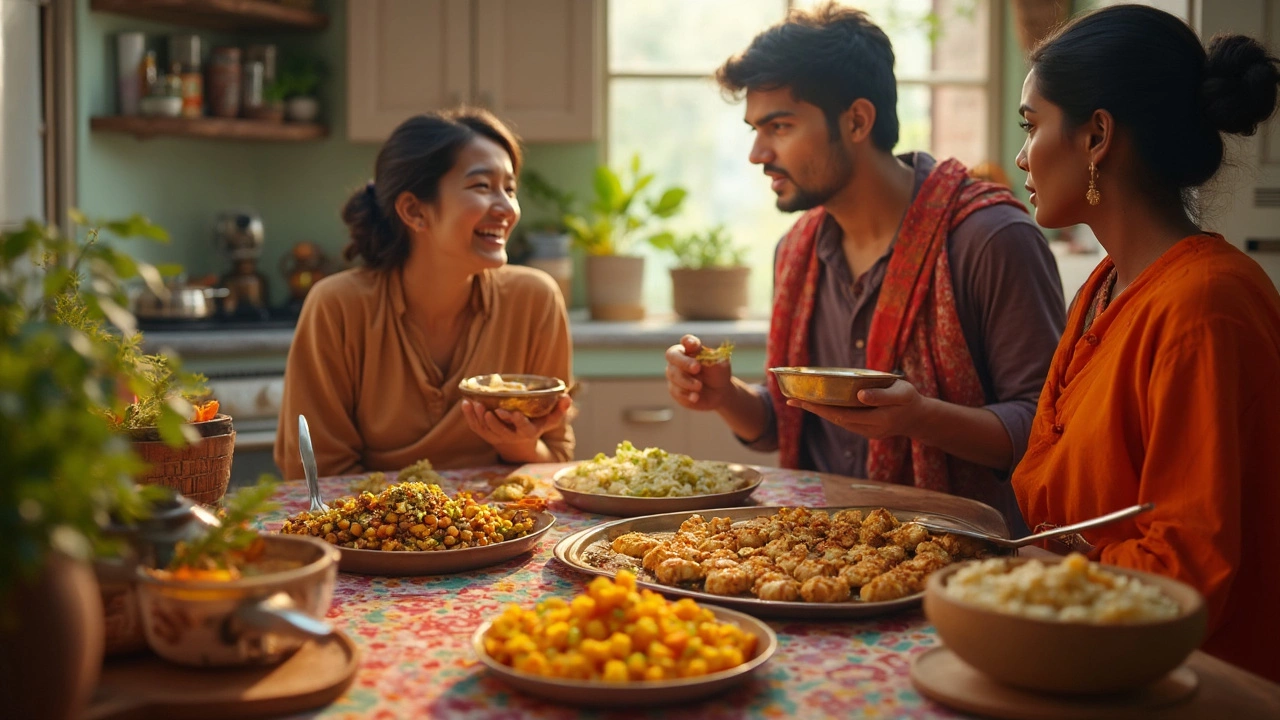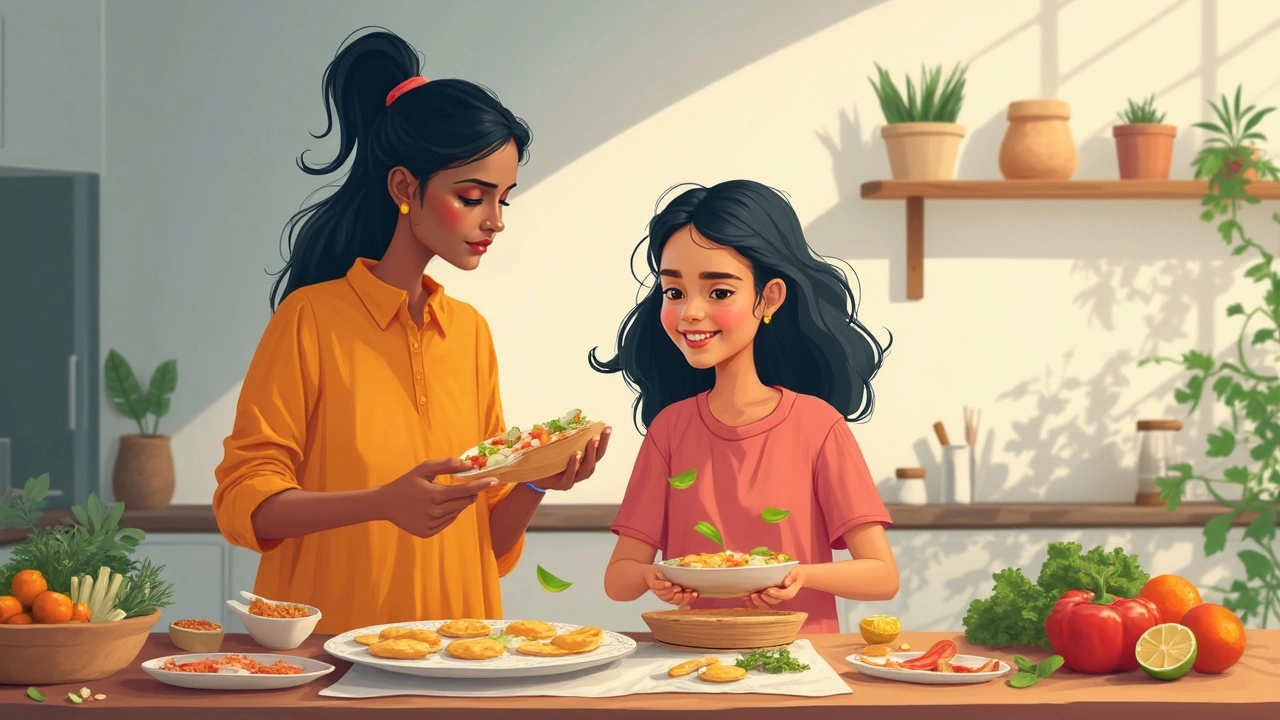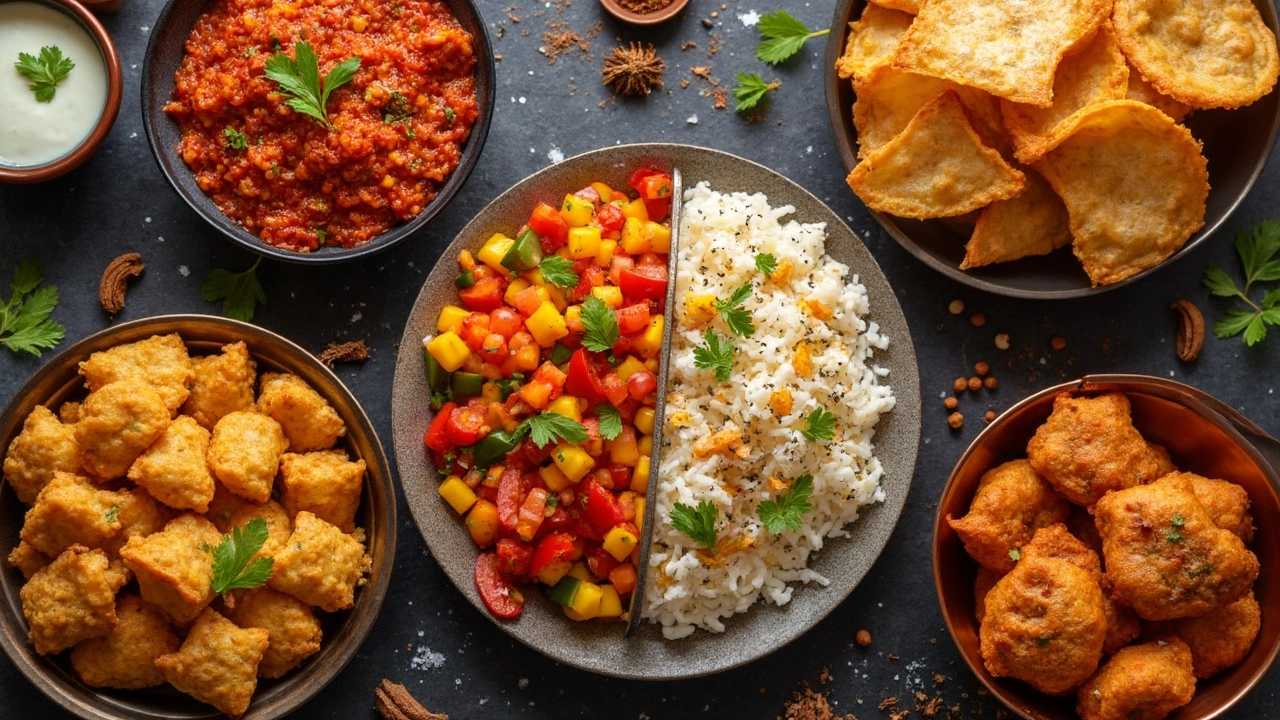What Indian Food Is Not Fattening? Healthy Indian Snacks to Satisfy Your Cravings
 Apr, 30 2025
Apr, 30 2025
Think Indian food and you probably picture hearty curries, loads of rice, and deep-fried street food. But here’s the thing: tons of Indian snacks are actually great if you’re trying to dodge extra calories. The trick is knowing which ones to reach for—and which to shove aside.
The good news? You don’t have to give up on flavor. Classic snacks like roasted chana, steamed idlis, or cucumber chaat won’t blow up your calorie count. A lot of these options are high in fiber or protein, so they keep you satisfied longer, avoiding the munchies that drive you back to the kitchen ten minutes later.
Fatty snacks usually sneak in extra oil or refined flour. Pakoras, samosas, and bhujia are literally dripping with it. Instead, think of light bites grilled, roasted, or steamed—the kind of stuff grandma would suggest if you told her you’re on a diet. Swapping out frying for steaming or baking makes a huge difference.
- Why Indian Snacks Can Be Tricky for Weight Watchers
- Low-Calorie Indian Snacks You Can Rely On
- Hidden Calories: What to Watch Out For
- Smart Snacking Tips: How to Enjoy More, Weigh Less
- Homemade vs. Store-Bought: Making the Healthier Choice
Why Indian Snacks Can Be Tricky for Weight Watchers
If you’re trying to choose healthy Indian snacks, there’s a pretty big catch: some snacks are pure carb bombs, while others secretly swim in oil or sugar. Classic munchies like samosas, kachoris, and pakoras are fried in enough oil to blow past your daily calorie limit in a few bites. Even things that sound healthy—like some store-bought sev or namkeen—usually pack in added fats, salt, and preservatives.
Some Indian snacks are loaded with hidden stuff—white flour (maida), ghee, or extra sugar. The problem? It’s easy to eat twice as much as you planned. Snack portions in India aren’t always small, and it’s totally normal to polish off a plate of chakli or bhujia while watching TV without realizing you’ve snacked through half your calorie budget for the day. A study by the Indian Journal of Community Health found that frequent snacking on oil-rich foods increases obesity risk among urban adults by over 40%.
Here’s a quick look at how calorie-dense some common snacks can get:
| Snack | Average Calories (per serving) |
|---|---|
| Samosa (1 piece) | 130 |
| Papdi Chaat (1 plate) | 300 |
| Fried Bhujia (1 handful) | 200 |
| Roasted Chana (1 handful) | 70 |
There’s an even sneakier side: snacks in India aren’t just for tea time. Families snack all day—at work, on the road, or in traffic. These little bites add up way faster than you’d guess.
"Traditional fried snacks can increase your calorie intake quickly. Choosing healthier, home-prepared options is key for anyone focused on weight management." — Dr. Aparna Joshi, Senior Dietitian
If you’re not paying attention, non fattening Indian food options like roasted makhana or steamed dhokla get drowned out by the deep-fried stuff. So, always check how your snack is made, keep an eye on portions, and don’t get fooled by the word ‘homemade’ if the oil is still flowing like water.
Low-Calorie Indian Snacks You Can Rely On
If you want to stick to healthy Indian snacks without worrying about weight gain, there’s actually a solid list of options. Most of these snacks keep the calories down by skipping the deep frying and using more natural, whole ingredients. Here’s what should be in your snack rotation:
- Steamed Idlis: These are the OG low-calorie South Indian breakfast, made from fermented rice and urad dal. Four small idlis give you about 140 calories. Best part? No oil required.
- Roasted Chana: Roasted chana is crunchy, salty, and loaded with protein and fiber. A small handful (30g) is roughly 120 calories and keeps you feeling full.
- Moong Dal Chilla: These savory pancakes are gluten-free, packed with protein, and can be loaded up with veggies. One chilla is around 100-120 calories, depending on size.
- Khandvi: A Gujarati snack, made from gram flour and yogurt, khandvi is light, tangy, and super low in calories—6-8 pieces are about 120 calories.
- Vegetable Upma: This is a filling semolina porridge. Add lots of veggies and skip the ghee to keep a serving at just 180 calories.
- Cucumber or Sprout Chaat: Cut up cucumber, tomato, onions, and toss with moong sprouts, lemon, and chaat masala. Hardly any calories, lots of crunch and taste.
- Bhel Without Sev: If you ditch the fried sev, puffed rice bhel with veggies and chutneys can be under 150 calories a bowl.
If you want quick numbers, here’s how the calories for a few common low calorie Indian food snacks stack up:
| Snack | Serving Size | Approx. Calories |
|---|---|---|
| Steamed Idlis | 4 pieces | 140 |
| Roasted Chana | 30g | 120 |
| Moong Dal Chilla | 1 piece | 120 |
| Khandvi | 6-8 pieces | 120 |
| Vegetable Upma | 1 cup | 180 |
The best part about these non fattening Indian food snacks? You won’t feel like you’re missing out—they’re flavorful, keep you full, and don’t mess up your diet plan. Stock up on these the next time hunger kicks in.

Hidden Calories: What to Watch Out For
When you’re banking on healthy Indian snacks to keep the scale in check, sneaky calories can still mess things up. These calories often slide in through stuff you don’t think twice about—extra oil, hidden sugar, and even toppings. Some snacks that look downright healthy are actually loaded with calories just because of the way they’re made or what’s added in the last minute.
Take dhokla or poha, for example. They seem low in calories, but the tadka (tempering) can triple fat content if it’s heavy on oil or topped with sev. Same goes for bhel puri: it starts off with puffed rice (all good), but then comes the fried puris, sev, and sugary chutneys, suddenly turning your light snack into a calorie bomb.
If you’re picking up low calorie Indian food that’s packaged, always check the ingredient list. Most store-bought snacks—like soan papdi, masala peanuts, or even roasted namkeen—can have way more sugar, salt, and fat than you’d expect. Also, watch the serving sizes. One packet doesn’t always mean one serving. For example, a small bag of masala makhana could say it’s two servings, but let’s be real—who stops halfway?
- Use less oil when cooking—even a single tablespoon adds 120 calories.
- Ask for chutneys and toppings on the side so you can control the portions.
- Bake or air-fry instead of deep frying whenever possible.
- Measure out snacks instead of eating out of the packet.
Curious about how calories stack up in popular snacks? Here’s a quick data snapshot:
| Snack | Average Calories Per Serving |
|---|---|
| Roasted chana (30g) | 120 |
| Poha (1 cup) | 200 |
| Bhel puri (1 plate) | 300-400 |
| Samosa (1 medium) | 140-180 |
| Masala peanuts (30g) | 170 |
Those numbers can swing higher with extra oil or added fried bits. Bottom line—if you’re trying to stick with non fattening Indian food, go easy on the extras, always check what oils or ghee go in, and try prepping snacks at home where you control what’s in the mix.
Smart Snacking Tips: How to Enjoy More, Weigh Less
Staying fit isn’t about skipping snacks—it’s about healthy Indian snacks and how you eat them. There are ways to enjoy plenty of flavor without piling on calories. You just have to be a little strategic in the kitchen and while shopping. Here’s what works for a lot of folks trying to eat lighter while still loving their food.
- Portion sizes matter. Even if you’re munching roasted chana or sprout salad, going overboard can still mean extra calories. Start with a small bowl, not the whole jar.
- Use less oil—seriously. Ditch deep-frying. Roasting, steaming, or air-frying gives you that crunch with way less fat.
- Add veggies. Packing your snack with cucumber, tomatoes, carrots, or leafy greens bulks it up with barely any extra calories. Something like moong dal chaat with lots of onions and tomatoes is an easy win.
- Mind your timing. Late-night snacking is usually mindless and, honestly, rarely about real hunger. Try keeping snacks to the afternoon slump or between proper meals.
- Pay attention to sauces and chutneys. That little bowl of imli chutney or creamy raita can sneak in a lot of sugar or fat. Opt for mint chutney without added sugar instead.
You want to see how some common healthy Indian snacks stack up on calories? Here’s a quick comparison based on typical homemade portions. Notice how method and ingredients totally change the game.
| Snack | Calories (per serving) | How It’s Prepared |
|---|---|---|
| Baked samosa | 120 | Baked, potato filling |
| Steamed idli (2 pieces) | 70 | Steamed, rice and urad dal |
| Roasted chana (30g) | 100 | Roasted, plain |
| Papdi chaat (fried) | 250 | Fried, uses potatoes and chutneys |
The takeaway? You can eat snacks every day if you focus on non fattening Indian food and swap out frying for roasted or steamed versions. Don’t let snacks become a mindless habit—plan them a bit, load up the veggies, and use your everyday kitchen gadgets. You’ll enjoy more, and the scale won’t notice a thing.

Homemade vs. Store-Bought: Making the Healthier Choice
If you’re aiming for healthy Indian snacks, you really want to think about where your food’s coming from—your own kitchen or a packet from the store. Here’s the truth: homemade usually wins by a mile. When you make snacks yourself, you control the oil, salt, and sugar. With store-bought stuff, even the so-called ‘healthy’ labels can be pretty sneaky.
Take a look at the back of any packet—there’s usually a laundry list of unpronounceable ingredients. Store-bought Indian snacks are packed with preservatives, hidden sugars, and unhealthy fats that can quietly mess up your weight loss snacks game. Even snacks labeled as ‘baked’ or ‘low-fat’ often aren’t that great, since manufacturers might add extra starch or flavoring to make up for taste.
| Snack Type | Homemade (Per 30g) | Store-Bought (Per 30g) |
|---|---|---|
| Roasted Chana | ~120 kcal, Low sodium | ~150 kcal, High sodium |
| Baked Samosa | ~100 kcal, No additives | ~170 kcal, Added preservatives |
| Murukku | ~140 kcal, Custom spice | ~180 kcal, Palm oil |
The difference is clear. Store-bought versions almost always have more calories, sodium, and sometimes even sugar compared to what you’d make at home. If you’re after low calorie Indian food or just want to stay in control, cooking at home is the way to go.
You don’t need to go full chef. Simple swaps make a big impact. Try roasting peanuts in your oven instead of buying salted ones. Pop your own makhana (fox nuts) with a pinch of salt and turmeric. For something sweet, mix hung curd with fruit instead of reaching for pre-packaged lassi or mithai full of added sugar. It’s also cheaper in the long run and you skip all the weird chemicals.
So next time you get a craving, consider what goes into your snack. Homemade doesn’t just taste better—it helps you actually stick to eating non fattening Indian food without feeling like you’re missing out.